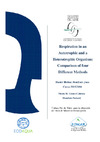Identificador persistente para citar o vincular este elemento:
https://accedacris.ulpgc.es/jspui/handle/10553/18442
| Campo DC | Valor | idioma |
|---|---|---|
| dc.contributor.advisor | Gómez Cabrera, María Milagrosa | - |
| dc.contributor.advisor | Packard, Theodore Train | - |
| dc.contributor.author | Bondyale Juez, Daniel Rickue | - |
| dc.contributor.other | Facultad de Ciencias del Mar | en_US |
| dc.date.accessioned | 2016-09-17T02:31:03Z | |
| dc.date.accessioned | 2018-05-15T10:52:11Z | - |
| dc.date.available | 2016-09-17T02:31:03Z | |
| dc.date.available | 2018-05-15T10:52:11Z | - |
| dc.date.issued | 2016 | en_US |
| dc.identifier.uri | https://accedacris.ulpgc.es/handle/10553/18442 | |
| dc.description.abstract | In the following research we studiedthe differences between the respiratory behavior of an autotrophic and a heterotrophic organism while at the same time comparingdifferent respiration measurement techniques. The respiration methodologies were the Winkler method, oxygen electrodes, oxygenoptodes and the kinetic assay for the respiratoryelectron transport system (ETS), methods that allow the determination of both physiological and enzymatic respiration. The organisms chosen for these experiments were a coastal crustacean, the mysid Leptomysis lingvura, and a coastal macroalgae, the chlorophyte, Ulvarigida.This work will briefly introduce the ecology of L. lingvuraand U. rigidaas well as explain the interest and importance of respiration and its measurement. It will continue with the description of each method used for a better understanding of their strengths and weaknesses. Then the results will be discussed and finally used to draw conclusions on the comparability of these methods and on the differences between the mysidand Ulvarespiration and their possible physiological and biochemical causes. | en_US |
| dc.format | application/pdf | es |
| dc.language | eng | en_US |
| dc.relation | Metabolismo planctónico: Regulación Bioquímica e Impacto Oceanográfico sobre la Bomba Biológica | en_US |
| dc.rights | by-nc-nd | es |
| dc.subject | 2510 Oceanografía | en_US |
| dc.subject.other | Respiración | en_US |
| dc.subject.other | Organismos autotróficos | en_US |
| dc.subject.other | Organismos heterotróficos | en_US |
| dc.title | Respiration in an autotrophic and a heterotrophic organism: comparison of four different methods | en_US |
| dc.title.alternative | Estudio comparativo de la respiración en organismos autotróficos y heterotróficos a partir de diferentes métodos | en_US |
| dc.type | info:eu-repo/semantics/masterThesis | en_US |
| dc.type | MasterThesis | en_US |
| dc.compliance.driver | 1 | es |
| dc.contributor.departamento | Departamento de Biología | en_US |
| dc.contributor.facultad | Facultad de Ciencias del Mar | en_US |
| dc.identifier.absysnet | 726662 | es |
| dc.identifier.crisid | 45197 | |
| dc.investigacion | Ciencias | en_US |
| dc.rights.accessrights | info:eu-repo/semantics/openAccess | es |
| dc.type2 | Trabajo final de máster | en_US |
| dc.description.notas | Máster en Oceanografía ; 2015-2016 | en_US |
| dc.utils.revision | Sí | en_US |
| dc.identifier.matricula | TFT-37380 | es |
| dc.identifier.ulpgc | Sí | en_US |
| dc.contributor.buulpgc | BU-BAS | en_US |
| dc.contributor.titulacion | Máster Universitario en Oceanografía | es |
| item.grantfulltext | open | - |
| item.fulltext | Con texto completo | - |
| crisitem.author.dept | GIR ECOAQUA: Ecofisiología de Organismos Marinos | - |
| crisitem.author.dept | IU de Investigación en Acuicultura Sostenible y Ecosistemas Marinos (IU-Ecoaqua) | - |
| crisitem.author.orcid | 0000-0002-2381-5371 | - |
| crisitem.author.parentorg | IU de Investigación en Acuicultura Sostenible y Ecosistemas Marinos (IU-Ecoaqua) | - |
| crisitem.author.fullName | Bondyale Juez, Daniel Rickue | - |
| crisitem.project.principalinvestigator | Gómez Cabrera, María Milagrosa | - |
| crisitem.advisor.dept | GIR ECOAQUA: Ecofisiología de Organismos Marinos | - |
| crisitem.advisor.dept | IU de Investigación en Acuicultura Sostenible y Ecosistemas Marinos (IU-Ecoaqua) | - |
| crisitem.advisor.dept | Departamento de Biología | - |
| crisitem.advisor.dept | GIR ECOAQUA: Ecofisiología de Organismos Marinos | - |
| crisitem.advisor.dept | IU de Investigación en Acuicultura Sostenible y Ecosistemas Marinos (IU-Ecoaqua) | - |
| Colección: | Trabajo final de máster | |
Visitas
64
actualizado el 10-ene-2026
Descargas
87
actualizado el 10-ene-2026
Google ScholarTM
Verifica
Comparte
Exporta metadatos
Este elemento está sujeto a una licencia Licencia Creative Commons

